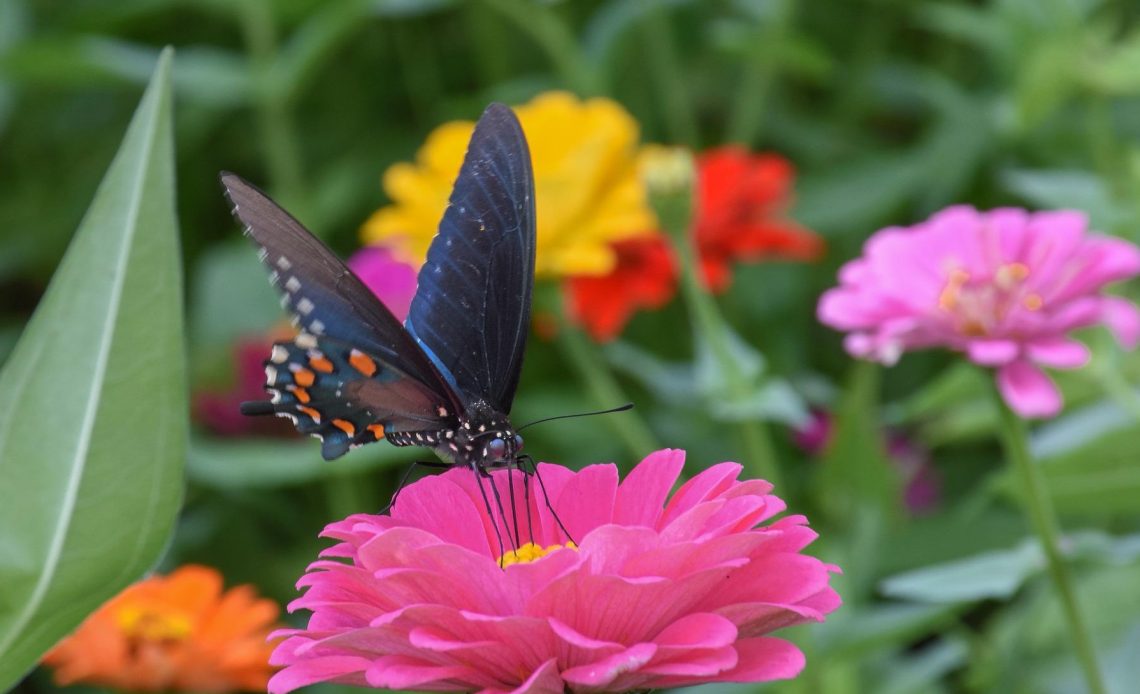

We’re here to help! Wild Yards is a completely free website that is 100% dedicated to helping you create a wildlife-friendly, sustainable yard. Read more
WildYards is reader-supported. When you buy a product through a link on our site, we may earn a comission. Every product is independently selected by our (obsessive) editors and our reviews are unbiased and objective. Read more about our mission or our privacy policy.
Dahlias grow in various shapes, sizes, patterns, and colors. You may be hard-pressed to find a dahlia that you don’t like! They are also beneficial for attracting lots of pollinators to gardens. But, do butterflies like dahlias?
Butterflies will visit dahlias, but not all. These insects need easy access to nectar, and some closed-flower varieties can prove difficult to feed on. Otherwise, open-flowered varieties will attract more than just butterflies – and in the right conditions, they can make a beautiful addition to any garden.
Why do butterflies like dahlias?
Butterflies are attracted to bold and bright colors. They specifically prefer reds, oranges, and yellows – and dahlias commonly show off these shades, alongside peaches, whites, and pinks. Some of the more striking dahlias – such as Taxi Drivers – simply attract butterflies because they’re easier to spot!
Dahlias commonly have large flower heads that provide perfect landing spots for butterflies. Unlike hummingbirds, which feed on flowers while hovering, butterflies need a platform to rest on while dipping into flowers for nectar.
Open-flowered dahlias popular with butterflies include the Peony, Orchid, and Anemone varieties. These are among the most convenient for their landing spots. More complex-flowered dahlias, such as Cactus and Ball varieties, prove to be less popular – they are trickier to feed on.
There are exceptions to this rule – the Gallery LaTour dahlia, for example, is double-flowered – but appeals to butterflies as it has an obvious, nectar-rich center.
Other flowers, too, while attractive to butterflies, can be difficult to access. While butterflies love roses, for example, their flower structures can restrict them from feeding openly.
Dahlias are famously rich in nectar, making them highly appealing to many pollinators. Butterflies may not get much competition from bees around reddish dahlias, on the other hand – as they are color-blind to this end of the spectrum.
What butterfly species do dahlias attract?
Open-flowered dahlias appeal to most species of butterflies, especially Monarchs. Monarchs are among the most recognizable species of butterflies due to their bright orange wings with black and white markings. They’re also greatly endangered – so by growing single-flower species, you’re helping to give back to the local ecosystem.
You’re also likely to find Painted Lady butterflies fluttering around dahlias in your yard. These insects are much less endangered than Monarchs – and are found all over the world. Spotting black-and-orange winged insects around your blooms will generally mean you’re off to a great start.
How to grow dahlias to attract butterflies to your garden
Growing dahlias to attract butterflies is relatively simple, given that both the flower and the insect adore sunny, wide-open spaces. As dahlias are native to Mexico, they enjoy hot weather, lots of sunlight, and do not fare well in the cold. They grow from tubers, rather than seeds.
When you choose the variety you like (paying close attention to the shape, size, patterns, and colors), you can plant the tubers directly in the ground in the spring. Ensure that the final frost has passed before planting them, or the tubers could die from the cold. Given the butterfly’s taste for hot colors, you should grow red, pink, and orange varieties for the best results.
They need to be planted about six inches in the soil and need lots of drainage. Plant them in an area with plenty of sunlight. Butterflies normally won’t fly towards shaded areas unless they have to – so don’t worry about keeping dahlias in the open.
You can spritz dahlias with occasional water during the growing season, but never leave the soil wet – too much moisture will cause serious problems.
Once the season is over, retrieve the tubers from the soil and keep them in a cool, dry place. If the frost does not harm them, the tubers can be replanted the next year and bloom again to welcome more Monarchs and Painted Ladies.
It’s a good idea to balance dahlias with other butterfly-friendly flowers – such as daisies and sunflowers – to provide an attractive variety your pollinators will happily return to.
Which flowers attract butterflies the most?
There is a wide variety of plants and growths that attract butterflies, from milkweed and willow to lantanas, petunias, and snapdragons. A safe pattern to follow is to plant flat, open-flowered, fiery blooms that thrive in the sun.
The age of the butterfly or caterpillar will also dictate the flowers that they will choose to eat. For example, many caterpillars need host plants. These plants need to provide the perfect shelter and nourishment for the caterpillars as they grow.
Butterflies may also prefer local species of flowers and plants, though the dahlia may prove to be an exception. It’s not technically native to the US, but is cultivated specifically as a perennial in USDA zone 7 and above.
Are dahlias the best flowers I can grow to attract butterflies?
Dahlias are great for attracting butterflies, though other blooms – such as the reliable sunflower – tend to welcome more frequent pollinators. The complex structures of various dahlias and their flowers can mean butterflies prefer an easier feast somewhere else.
Do grow simple-shaped dahlias if you want to try bringing Monarchs to your yard – but make sure to blend them with proven butterfly favorites, too.
